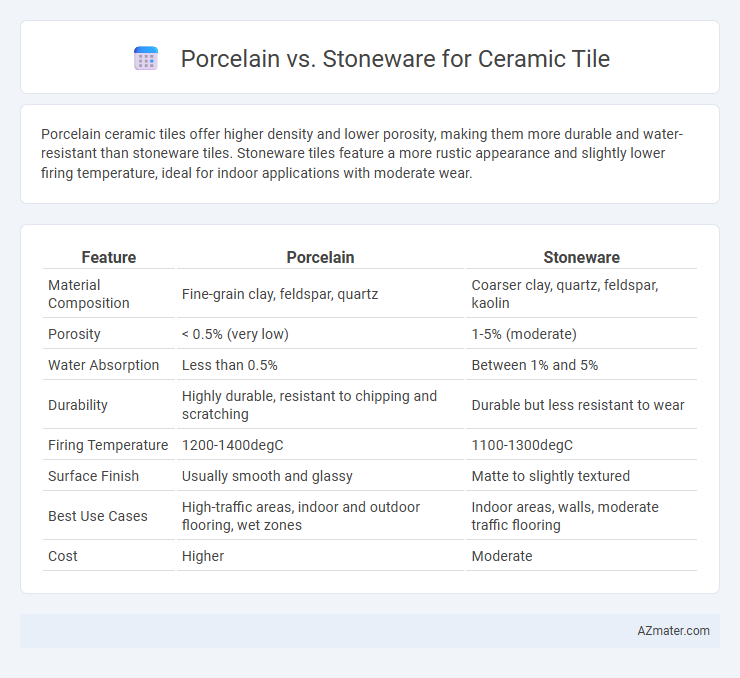Porcelain ceramic tiles offer higher density and lower porosity, making them more durable and water-resistant than stoneware tiles. Stoneware tiles feature a more rustic appearance and slightly lower firing temperature, ideal for indoor applications with moderate wear.
Table of Comparison
| Feature | Porcelain | Stoneware |
|---|---|---|
| Material Composition | Fine-grain clay, feldspar, quartz | Coarser clay, quartz, feldspar, kaolin |
| Porosity | < 0.5% (very low) | 1-5% (moderate) |
| Water Absorption | Less than 0.5% | Between 1% and 5% |
| Durability | Highly durable, resistant to chipping and scratching | Durable but less resistant to wear |
| Firing Temperature | 1200-1400degC | 1100-1300degC |
| Surface Finish | Usually smooth and glassy | Matte to slightly textured |
| Best Use Cases | High-traffic areas, indoor and outdoor flooring, wet zones | Indoor areas, walls, moderate traffic flooring |
| Cost | Higher | Moderate |
Introduction to Ceramic Tile Materials
Porcelain and stoneware are two primary ceramic tile materials characterized by their durability and composition. Porcelain tiles are made from highly refined clay fired at higher temperatures, resulting in a denser, less porous surface ideal for high-traffic areas and moisture-prone environments. Stoneware tiles, crafted from a blend of natural clays and fired at slightly lower temperatures, offer a more porous texture with a warm, rustic aesthetic suitable for residential applications.
What is Porcelain Tile?
Porcelain tile is a type of ceramic tile made from highly refined clay and fired at higher temperatures, resulting in a denser, more durable material. It is less porous than stoneware, making it more resistant to moisture, stains, and wear, ideal for high-traffic areas and outdoor use. Its fine grain and smooth surface allow for a wide range of styles and finishes, including polished, matte, and glazed options.
What is Stoneware Tile?
Stoneware tile is a type of ceramic tile made from refined natural clay, fired at lower temperatures than porcelain, resulting in a denser, more vitrified material than traditional earthenware. It typically exhibits a slightly more porous surface than porcelain but offers durability and a natural, earthy aesthetic that suits both indoor and outdoor applications. Stoneware tiles are available in a range of finishes and textures, providing versatility for flooring, wall coverings, and decorative accents.
Key Differences Between Porcelain and Stoneware
Porcelain and stoneware ceramic tiles differ primarily in their composition and firing temperature, with porcelain being made from finer clay and fired at higher temperatures, resulting in a denser, more durable tile. Porcelain tiles typically exhibit lower water absorption rates, making them more suitable for moisture-prone areas, while stoneware has a slightly more porous structure and a warmer, rustic aesthetic. The greater hardness and resistance to wear of porcelain make it ideal for high-traffic spaces, whereas stoneware offers more variation in texture and color, favored for decorative or low-traffic applications.
Durability and Strength Comparison
Porcelain ceramic tiles exhibit higher density and lower porosity compared to stoneware, resulting in superior durability and enhanced resistance to wear, stains, and moisture. Stoneware tiles, while strong, typically have a more porous composition that makes them less suited for high-traffic or moisture-prone areas. The greater hardness and frost resistance of porcelain make it the preferred choice for both indoor and outdoor applications where longevity and strength are critical.
Water Absorption and Resistance
Porcelain ceramic tiles exhibit a water absorption rate of less than 0.5%, making them highly resistant to moisture and ideal for wet environments. Stoneware tiles generally have a higher absorption rate between 3% and 7%, which decreases their suitability for areas exposed to water. The lower porosity of porcelain enhances its durability and resistance to staining, compared to the more porous nature of stoneware.
Aesthetic and Design Options
Porcelain tiles offer a wide range of aesthetic options, including polished, matte, and textured finishes that mimic natural stone, marble, and wood with high detail and color consistency. Stoneware tiles provide warmer, rustic designs with earthy tones and handcrafted textures, ideal for creating unique, artisanal looks. Both materials support versatile design styles, but porcelain excels in sleek, modern aesthetics, while stoneware emphasizes natural, organic appearances.
Installation and Maintenance Considerations
Porcelain ceramic tiles require a more precise installation process due to their density and hardness, often necessitating specialized cutting tools and skilled labor, while stoneware tiles are generally easier to cut and install with standard tools. Maintenance of porcelain tiles is minimal because of their non-porous surface, making them highly resistant to stains and water, whereas stoneware tiles may need regular sealing to prevent moisture absorption and staining. Both materials benefit from routine cleaning with pH-neutral products, but porcelain's durability reduces the frequency and intensity of maintenance over time.
Cost Comparison: Porcelain vs Stoneware
Porcelain tiles are generally more expensive than stoneware tiles due to their denser composition and higher firing temperatures, which enhance durability and water resistance. Stoneware offers a more affordable option while still providing reasonable strength and aesthetic appeal, making it popular for budget-conscious projects. Cost differences between porcelain and stoneware also reflect variations in manufacturing processes, with porcelain requiring more energy-intensive methods that drive up prices.
Which Tile is Best for Your Project?
Porcelain tiles offer higher density and water resistance, making them ideal for high-traffic or moisture-prone areas such as bathrooms and kitchens. Stoneware tiles provide a more rustic aesthetic with slightly lower durability, suited for decorative indoor applications and low-traffic zones. Evaluating project requirements like durability, moisture exposure, and design preference will determine whether porcelain or stoneware tiles best fit your specific needs.

Infographic: Porcelain vs Stoneware for Ceramic Tile
 azmater.com
azmater.com